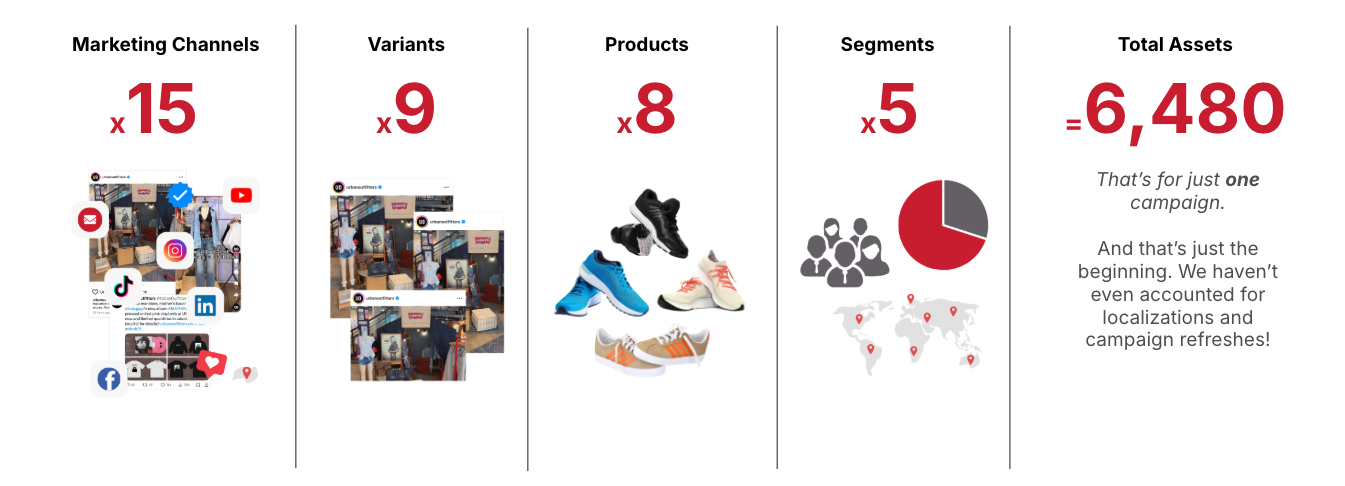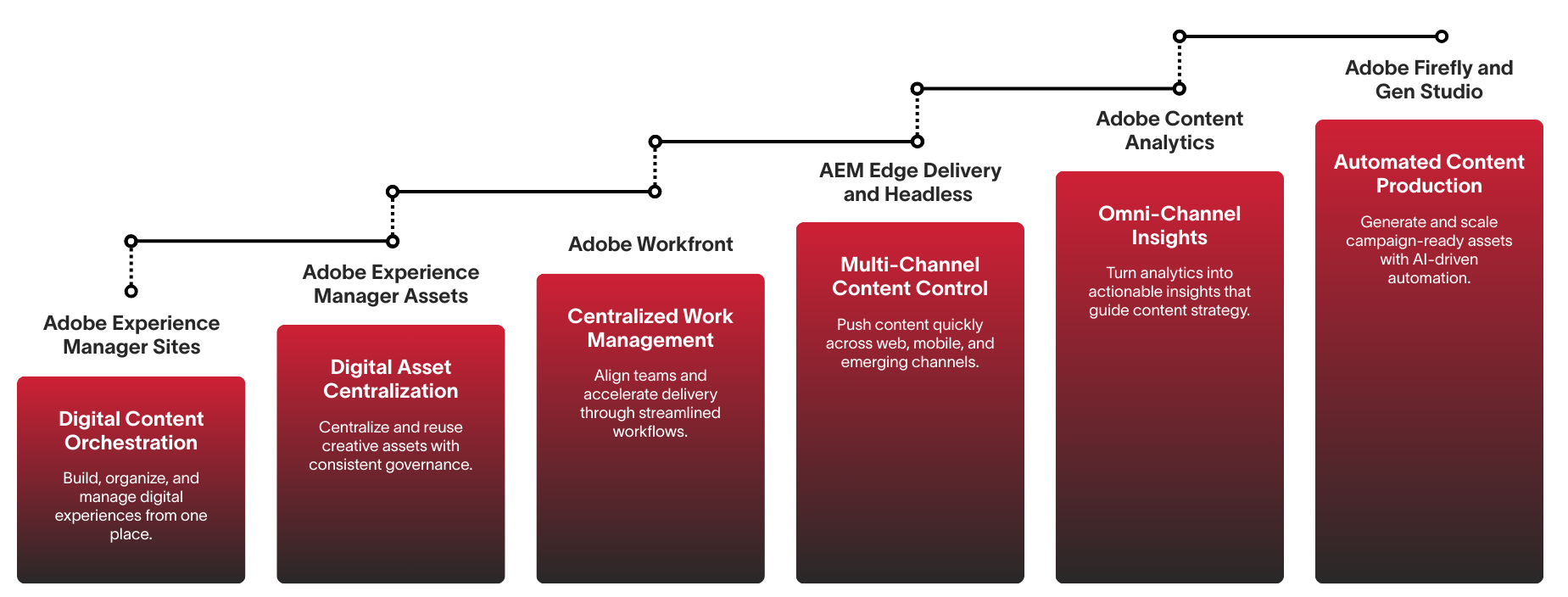Scaling Content with Generative AI: The Processes That Make It Work

Brendan Raybuck
Head of Growth, Northern
There’s been no shortage of hype around Generative AI in marketing content production — and for good reason. For decades, digital marketing promised the ability to deliver the right content, to the right person, at the right time.
Gen AI brings us closer than ever to fulfilling that promise. But as with every major technology shift, the real differentiator isn’t the tool itself. It’s how teams adapt their ways of working, how processes evolve, and how success gets measured.
At Northern, we’ve been watching this evolution closely. Here’s our take on how we got here, where the opportunities lie, and what you need to know to make Gen AI a powerful part of your content supply chain.
This Isn’t as New as It Seems
Generative AI may feel revolutionary, but it’s really another step in the long dance between content and data.
In the early days of digital marketing, web content management systems emerged in the late ’90s, but adoption didn’t truly take off until web analytics platforms matured in the mid-2000s. Suddenly, marketers could see performance data and wanted the ability to change and test content faster.
From there the demand only grew:
- A/B testing drove demand for alternate versions of copy and design.
- Email marketing opened an entirely new channel.
- Digital advertising exploded, requiring creative production at an unprecedented pace.
Fast forward to today: enterprise organizations have powerful platforms like Adobe Real-Time CDP, Tealium AudienceStream, Salesforce Data Cloud, and Segment to unify customer data. They pair these with cross-channel analytics tools such as Adobe Customer Journey Analytics, Google Analytics 4, and Tableau to see behaviours in real time. Layer on advanced segmentation capabilities in platforms like Adobe Target or Optimizely, and marketers can identify micro-audiences with unique interests.
In theory, this enables precise personalization.
Why Bad Ads Still Follow You Around
If personalization tools are so advanced, why do you still get irrelevant emails or see ads for products you’d never buy?
The problem is scale. Each micro-segment requires its own landing pages, emails, ads, and posts. Multiply that across dozens of segments, and the content demands quickly spiral into the thousands.
Even when analytics know you’re in the wrong segment, there’s often no capacity to produce a better-fitting asset. So you get dropped into the “closest match” segment. That’s why you might browse a winter jacket once and then see ads for snow boots all summer long, or get an email about baby products when you only bought a gift for a friend’s shower.
And as every marketer knows: hope is not a strategy.
Enter Generative AI
Generative AI promises to break this bottleneck by enabling marketing teams to create content variations at scale, personalized for micro-segments, across channels, and at the exact moment they’re needed.

Consider a single campaign: 15 marketing channels, 9 creative variants, 8 products, and 5 customer segments. That quickly adds up to more than 6,000 individual assets — before even factoring in translations or refresh cycles. No team can manually produce that volume without cutting corners.
That’s where Generative AI shows its value. Instead of spending weeks creating assets by hand, teams can generate thousands of variations in seconds, then refine and approve only what matters most. The result is faster speed-to-market, more personalized content, and a scalable way to keep pace with customer expectations.
But while the potential is massive, the results aren’t instant. Gen AI comes with challenges:
- Hallucinations: AI may generate inaccurate or off-brand content. For example, AI might generate a product description with features that don’t actually exist.
- Brand Consistency: Maintaining voice and authenticity requires careful oversight. An AI-written ad might sound right in one channel but come across as off-tone or robotic in another.
- Ethical & Legal Risks: Misuse or lack of governance can have reputational and regulatory consequences. Without oversight, AI could produce content that unintentionally violates copyright or makes unapproved claims.

Generative AI Is Enterprise-Ready — With the Right Approach
Like past innovations in marketing automation or content management, Gen AI can transform your operations, but only if you adapt your processes and mindset.
Here are four truths about scaling Gen AI for marketing content:
- AI quality depends on training data. Your models need to be fine-tuned on your brand’s tone, visuals, and guidelines. Your AI should be training on your tone, voice, and visual style.
- Context matters. AI should understand the target channel to generate the right format and style variations. For example, a LinkedIn post needs to sound professional and concise, while an Instagram caption can be more playful and hashtag-driven.
- Review is essential. Even at scale, human oversight ensures compliance, accuracy, and nuance.
- Feedback fuels improvement. Track performance and feed results back into the AI to refine output over time.
Preparing Your Organization for Gen AI in Content
Bringing Generative AI into marketing isn’t just a matter of switching on a new tool. It requires building the right foundation so the technology can actually deliver value. That means aligning people, processes, and platforms around a new way of working.
To leverage Gen AI effectively, you’ll need a combination of purpose-built tools, structured governance, and workflows that blend automation with human oversight:
- Specialized Marketing AI Tools: Choose platforms built for creative and campaign work, not generic text generation.
- Digital Asset Management (DAM): Centralize and organize the surge of new content variations, while serving as the single source of truth that Generative AI can draw from to maintain brand consistency.
- Multi-Channel Delivery: Push and control AI-generated content across sites, social, email, and more without bottlenecks.
- Robust Creative Process: Combine automation with human refinement.
- Analytics & Optimization: Measure what works — and continuously improve.

Technology That Can Help
When it comes to innovation in marketing technology, Adobe leads the field with an integrated approach. If your organization is serious about putting Generative AI to work, you’ll need more than a text generator. You’ll need tools that can create, manage, govern, and measure content at scale. That’s exactly where Adobe’s ecosystem comes in:
- Firefly & GenStudio: Adobe Firefly delivers generative capabilities for images, text, and creative variations, while GenStudio brings those outputs into real campaign workflows. Together, they move teams from ideation to execution quickly, producing campaign-ready content that stays within brand guidelines.
- AEM Assets: Adobe Experience Manager (AEM) Assets serves as the single source of truth for digital content. It not only stores and organizes assets but also enforces governance, permissions, and version control, ensuring AI-generated content is compliant, consistent, and accessible across teams.
- AEM Sites: This tool allows enterprises to deliver personalized, AI-assisted content across websites, microsites, and digital experiences. By managing distribution centrally, teams can adapt AI-generated content for multiple audiences and channels without duplicating effort.
- Workfront: With AI generating content at volume, Workfront helps manage the human side — routing drafts for review, tracking revisions, and ensuring proper sign-off before assets go live. This brings order and accountability to a high-speed production environment.
- Content Analytics: Measure impact and feed insights with Content Analytics and close the loop by showing how AI-generated assets perform across channels. These insights feed back into the process, allowing marketing teams to refine prompts, prioritize the highest-performing variations, and continuously improve results.
Wondering Where to Start?
At Northern, we help enterprise teams cut through the hype and put Gen AI to practical use. That means more than technology rollouts. It’s about enabling the people and processes that make AI effective.
We focus on ensuring AI doesn’t just create more content, but the right content: aligned with brand voice, optimized for every channel, and measured for impact.
If it’s time to scale Generative AI into a true content supply chain, Northern can help get you there.
Stay informed, sign up for our newsletter.

